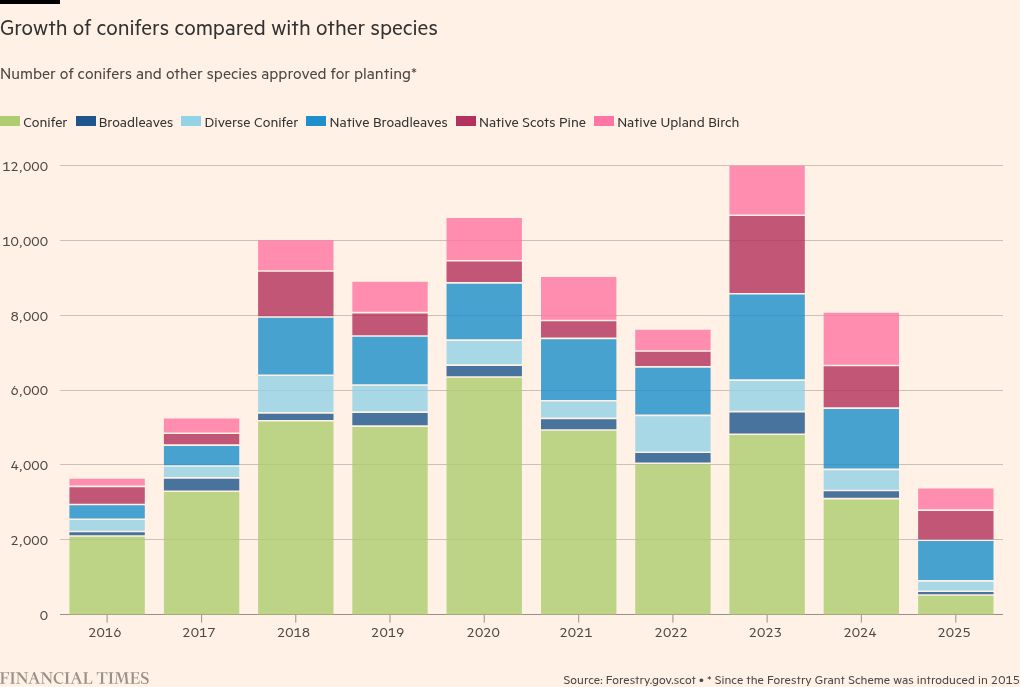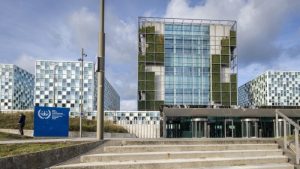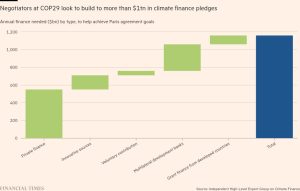Scotland’s ‘industrial-scale’ forestry triggers opposition in border town

Pensioner Archie Hyslop fears for the future of Langholm, a former mill town at the heart of Scotland’s legacy textile industry.
Dense forests are encircling his hometown near the border with England as investors snap up land to plant fast-growing trees for timber and carbon credits.
In response, residents have formed an action group to challenge the latest afforestation scheme that would, in their eyes, diminish the landscape’s natural beauty and biodiversity.
Industrial-scale forestry, they argue, is fuelling depopulation as tenant farmers are ousted to make way for projects that, supported by government grants and tax breaks, outbid those seeking to buy land for agriculture and nature restoration.
“Rural communities have been totally pillaged,” said Hyslop, 75, who has watched as shops and services close in Langholm. “Sadly, miles of monotonous spruce trees are emptying the sheep and cattle from our hills.”
The Warblaw forestry plan covers about 1,050 hectares on an imposing hill near Langholm, around 55 per cent of which would be retained for agriculture, with 20 per cent reserved for non-native Sitka spruce and another 10 per cent for broadleaf trees, such as oak and birch.
Under forestry standards, single species are restricted to 65 per cent of the planting area. Warblaw’s Sitka makes up 46 per cent. The activists, however, said an existing coniferous forest on the same hill would, in combination with the new scheme, raise the overall Sitka percentage to 65.4 per cent.
Sitka seeds, they added, have been blowing over the valley and disrupting broadleaf trees on a nearby nature reserve, home to endangered hen harriers. The reserve forms part of the town’s plans to develop nature-based tourism in an effort to create much-needed local jobs.

“This scheme is toxic and should be withdrawn,” said Oliver Mundell, the Scottish Conservative MSP representing Dumfriesshire. “These are the wrong trees, in the wrong place.”
The tension between shifting land use from agriculture to forestry is reflected across Scotland, where almost half of the UK’s woodlands are located. Conifers, including fast-growing Sitka spruce, make up more than 70 per cent of Scottish forests.
Foresters argue that these species are needed to reduce the UK’s dependence on imports for 80 per cent of its timber and to accelerate carbon capture to meet the country’s ambitious net zero targets.

Striking the right balance is a problem for the government, which through the Scottish Forestry agency both regulates the sector and funds planting projects.
Mairi Gougeon, the Scottish government’s rural affairs secretary, has assured campaigners in Langholm that a cumulative impact assessment will be carried out on the environmental effects of Warblaw and other planned afforestation schemes.
Scotland has twice the woodland of England, at 19 per cent of land use, but it still trails behind the European average of 46 per cent. The Scottish government’s strategy is to increase cover to reach 21 per cent by 2032.
New forestry has grown 0.26 per cent a year in southern Scotland, according to Scottish Forestry.
“The sensitivity is that the south is particularly suitable for productive conifer woodland, so if land becomes available, investors want that type of forestry,” said Brendan Callaghan, director of operational delivery.
A decade ago, a regional forestry planning document described the “extensively afforested hills” that surround the Esk valley to the north of Langholm, where the proportion of woodland cover had already reached 53 per cent.
Morag Paterson, who campaigns for more diverse woodland, said communities across the south were “really concerned” about the cumulative impact of commercial forestry. She called for more flexible grants to encourage diversification.
Scottish Woodlands, which is implementing the Warblaw scheme on behalf of a timber merchant, plans to start planting in the spring, if approved by Scottish Forestry. Felling would start in 2045.
Forestry advocates say that Sitka is a “supercharged carbon capture technology” that sequesters carbon more quickly than slower-growing native broadleaves, even if the latter capture more over the long term.
“The growth of timber and benefits of locking up carbon are important drivers,” said David Robertson, business development manager for Scottish Woodlands. “There is no conflict between forestry and agriculture, there is loads of space for the best use of ground.”
Activists disagree, saying their town has reached a tipping point as forestry expands at the expense of farming and tourism.
“We can’t later turn the clock back — the farms will be gone, the people will have left,” said Barbara Hill, another activist. “And nobody will want to visit our lovely valley because it won’t be lovely any more.”
Cartography by Cleve Jones
#Scotlands #industrialscale #forestry #triggers #opposition #border #town








